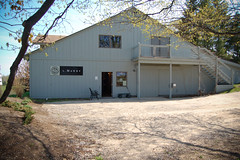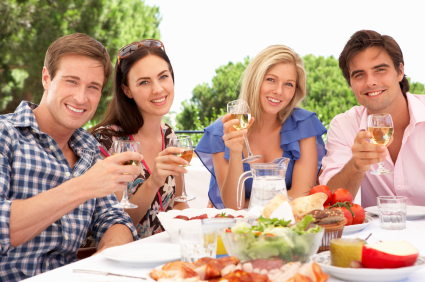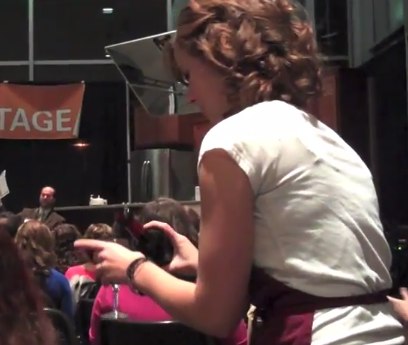Sparkling in the Midwest: L. Mawby and Ravenhurst Cellars
 Champagne is wine’s outgoing cousin — sparkling, fun, the life of the party — which may be why a number of Midwest wine makers are adding champagnes and sparkling wines to their product lineup. The Midwest has two vintners who excel at sparkling wines and the ‘methode champenoise” — Larry Mawby, located on Michigan’s Leelanau Peninsula, and Chuck Harris and Nina Busch of Ravenhurst Champagne Cellars near Mt. Victory, Ohio.
Champagne is wine’s outgoing cousin — sparkling, fun, the life of the party — which may be why a number of Midwest wine makers are adding champagnes and sparkling wines to their product lineup. The Midwest has two vintners who excel at sparkling wines and the ‘methode champenoise” — Larry Mawby, located on Michigan’s Leelanau Peninsula, and Chuck Harris and Nina Busch of Ravenhurst Champagne Cellars near Mt. Victory, Ohio.
Mawby has been making sparkling wine at his L. Mawby winery for 30 years. For 20 years, he produced still wines as well. That changed in the 1990s when the wine industry in Michigan exploded. To give L. Mawby wines an identity and edge in the new, competitive environment, Mawby decided to produce only sparkling wines – his premium L. Mawby wines, produced by the methode champenoise, and the M. Lawrence line, which are sparklers made using the cuvee close method.
‘The L. Mawby wine is made strictly from grapes grown in the Leelanau appellation,” he says, adding that grapes come from his own estate and from a half-dozen of what Mawby calls the ‘best wine growers in the area.” Mawby’s 18-acre vineyard is planted in those grapes traditionally used in sparkling wines – Vignoles as well as the vinifera varieties Pinot Noir (which are dominate in his vineyard), Pinot Gris, and Chardonnay — with some Seyval and Pinot Meunier grown as well. For his M. Lawrence line, Mawby buys grapes (primarily Chardonnay and Pinot Noir) from growers in southwestern Michigan as well as northern California, ‘There aren’t enough grapes on Leelanau to produce all the wines we make,” he explains.
When the grapes are ready to pick, everything is hand-harvested so grapes arrive in the press room as whole clusters. Mawby judges ripeness by flavor backed up by brix testing. He says, ‘We want as low a ph as possible and no brix reading higher than 20.” Newly harvested grapes are pressed in clusters with a Bucher tank press, and left to settle overnight. The juice then goes into small oak barrels for the premium L. Mawby wines and into stainless for his M. Lawrence line. Yeast and sugars are added according to the desired dryness for each wine. Once the first fermentation is complete, the wine is blended with reserve wine, although Mawby leaves two or three of his wines unblended. Next the wine is placed in bottles for the Mawby line or in a closed tank (cuvee close method) for his M. Lawrence line.
‘We bottle age from three to seven years,” says Mawby. During that time, riddling is done by a gyropalette, purchased from Champagne, France, as is most of Mawby’s equipment for disgorging, dosaging, corking, wirehooding and bottle washing. Bottles are imported from Reims. With two lines and 15 wines, Mawby’s annual production is about 15,000 cases. His M. Lawrence line, added in 2004, has allowed him to increase production, spend less time on aging, and produce new styles of sparkling wine. Mawby says he’d like to increase his production in the future, buying more fruit from more growers. Ultimately, he’d like to see his lines in wine shops everywhere.
Like Mawby, Chuck Harris and his wife Nina have been making wine for 30 years. Champagne, however, has always  been a part of their Ravenhurst lineup. As Harris puts it: ‘I married a woman who loves champagne, so I learned how to make it.” While Ravenhurst still produces table wines, poured at one of Columbus’s finest restaurants and at an exclusive country club resort in Delaware, Harris says producing a first-rate champagne is the focus of his winemaking.
been a part of their Ravenhurst lineup. As Harris puts it: ‘I married a woman who loves champagne, so I learned how to make it.” While Ravenhurst still produces table wines, poured at one of Columbus’s finest restaurants and at an exclusive country club resort in Delaware, Harris says producing a first-rate champagne is the focus of his winemaking.
He produces approximately 4,000 cases for one local restaurant and one local country club. Ravenhurst also has a patron list made up of clients who order his wines for their personal cellars. Whatever wine is left over, is sold in the tasting room. He doesn’t envision himself producing wine in quantities for mass distribution, nor does he see making sparkling wine from any fruit other than grapes.
Harris’ vineyard, similar to Mawby’s, is planted with Pinot Noir, Vignoles, and Chardonnay and also includes Cabernet Franc, Chambourcin, and some Burgundy and Dijon clones. Like many California growers, Harris finds the Pinot Noir grape a challenge. ‘It’s one of the most difficult vinferas to grow and work with,” he says. ‘But it’s the Holy Grail for winemakers.”
Like Mawby, Harris tests ripeness by taste we well as by the brix scale. When the flavor is there and the sugars developed, he turns to the brix. ‘We’ll go to 20 for the free-run wine; 21 for the still wines,” he says. adding he believes he is the only vintner who uses only free-run juice for his champagnes and the press for still wines.
He ages in both stainless and oak, depending on the wine, but when he ages in oak, he keeps unoaked juice on hand to blend with the oaked wine. That way, he says, the oak can recede further into the background and allow the delicate flavor of the fruit to shine. “It’s all about the blending,” says Harris. ‘You can blend a cuvee better than you can grow it.” Harris ages his grand cuvee for 10 years; otherwise, his champagnes age for about six years.
Mawby offers this advice to beginning champagne makers; ‘It all begins in the vineyard. Choose the best grapes you can and don’t slough off when the grapes come in for processing. We don’t want to taste the green, but we don’t want an excessively ripe grape either. Sparkling wines have to be very clean, without any technical flaws. That means working from clean grapes — no rot — and in a clean winery.”



